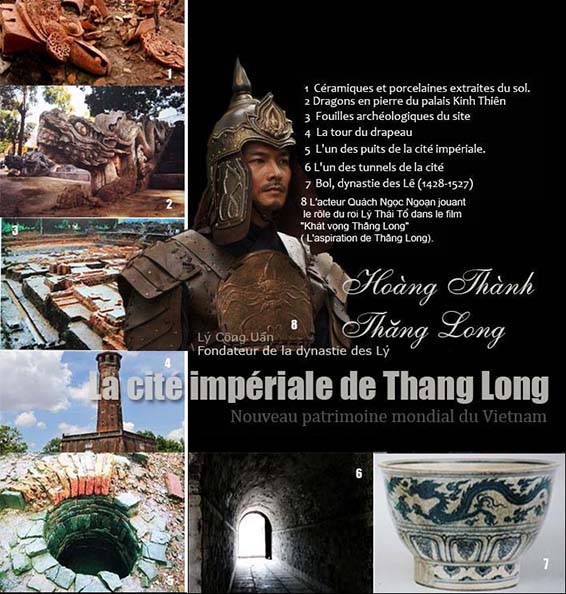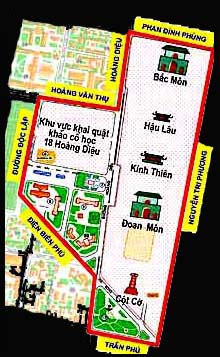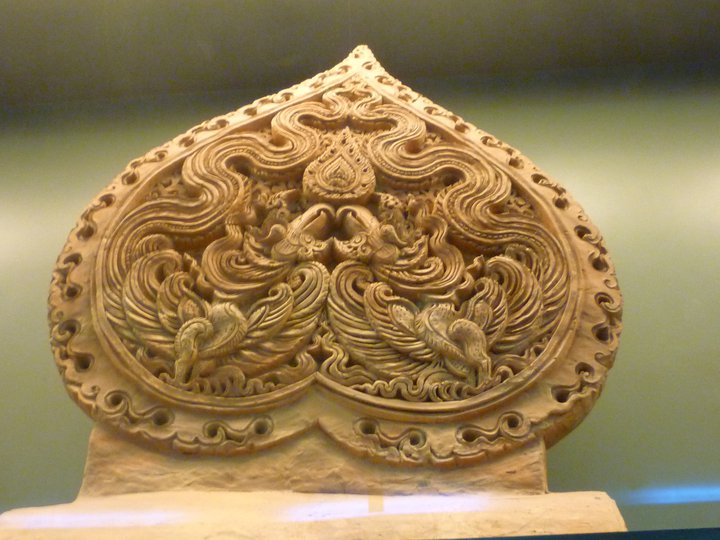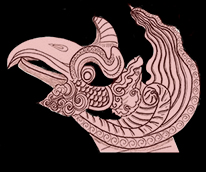
Vietnamese version
Version française
Pictures gallery
Due to historical events, the imperial city of Thăng Long seems to fade over time in the collective memory of the Vietnamese, with its remnants hidden within the land of the ancient city of Hanoi. Vietnamese archaeologists had difficulty locating its site despite a series of archaeological excavations initiated at Quần Ngựa and in the geographical area of the Hồ Chí Minh mausoleum, etc., since 1970. It was only in 1998 that they succeeded in locating, in the geographical areas near Hậu Lâu adjacent to Hoàng Diệu street and Bắc Môn (the North Gate from the Nguyễn period), bases of stone pillars and columns with lotus motifs as well as other manufactured objects from the later Lê period. In 2000, they were allowed to carry out another excavation inside Ðoan Môn (the only gate of the forbidden city), which led to the discovery of the royal road (ngự đạo) from the Trần period. With other archaeological excavations undertaken from December 2002 until 2004 near No. 18 Hoàng Diệu street, other remnants dating back to the pre-Thăng Long era (before the 11th century) were found.
Thanks to the picks of Vietnamese archaeologists, the imperial city of Thăng Long is beginning to reveal its secrets and politics, administration, and culture over nearly thirteen centuries (under the successive dynasties of Lý, Trần, and later Lê). The architectural ruins (foundations, pillar bases, sections of royal brick roads, water drainage systems, wells, etc.) exposed in the imperial city of Thăng Long undoubtedly testify to the architectural complexity of the palaces of that era, whose existence has been confirmed by the discovery and presence of several types of high-quality ceramics with aesthetically sophisticated motifs, including ceramics from the Lê period bearing Chinese characters meaning Quan (official) or Kính (respectful) and motifs of five-clawed dragons and phoenixes.
Imperial city map

These ceramics were reserved exclusively for kings and queens. Thanks to the archaeological excavation, the following conclusion was reached: the architectural remains from the Lý-Trần-Lê periods found had been stacked on the layer from the Chinese Zong Pinh-Đai La period (Tống Bình-Đai La) (7th-9th century).
This observation does not call into question the importance given until now to the Royal Edict (Chiếu dời đô) that the founder Lý Công Uẩn of the Lý dynasty, later known as Lý Thái Tổ, promulgated in the spring of 1010 (Canh Tuất) regarding the transfer of the capital. After eliminating the Vietnamese king Lê Long Ðĩnh of the earlier Lê dynasty (Tiền Lê), Lý Thái Tổ realized that after a few years of reign, Hoa Lư, the capital of Vietnam built in a mountainous region, was too difficult to access. It was impossible to ensure prosperity there and to secure the destiny of Vietnam (tính kế cho con cháu muôn vạn đời). The capital had to be transferred to Ðại La, the former capital of the proconsul of the Chinese Tang dynasty, Kao Pien (Cao Biền), during the period of Chinese domination.
Hoàng thành Thăng Long
This city could protect the population from floods and inundations with its fairly high and well-exposed terrain, but it was also a location corresponding to the favorable orientation of mountains and rivers and to the position of the coiled dragon and the sitting tiger. To avoid awakening popular unrest, he did not hesitate to resort to the credulity of his people, as would later be done by the advisor to the hero Lê Lợi, Nguyễn Trãi, in the liberation struggle against the Ming. He spread a rumor that he had seen a golden dragon emerge from Ðại La and fly into the sky in his dream.
That is why Đại La was called Thăng Long (The Rising Dragon). Like other kings, he could have imposed his will on his people by decree, but he preferred to submit to the will of Heaven and the aspirations of the people, deliberately using their superstition to accomplish a great work for an independent Vietnam. His reign was known as « Thuận Thiên » (Following the Will of Heaven).
Orphaned, raised in a pagoda, and educated from a young age by the learned monk Vạn Hạnh, growing up in his shadow, he soon became a great king of Vietnam because he was imbued with Buddhist thought during his reign. In him, one finds not only wisdom, dialogue, insight, and tolerance but also the undeniable will to contribute to the strengthening of the Vietnamese nation (a highly centralized administrative system, a fairly flexible tax regime, Buddhism accepted as the state religion, priority given to education, etc.). It was under him that Vietnam was recognized for the first time as the kingdom of Annam. The authors of the work « The Complete Historical Records of Đại Việt » (Ðại Việt Sử Ký toàn thư) continually praised the years of Lý Công Uẩn’s reign. His dynasty was later described by the Vietnamese historian Ngô Thì Sĩ as a dynasty of clemency (Triều Lý nhân Ái).

Decorative sheet attached to the tile
Thanks to Việt Sử lược (The Brief History of the Vietnamese State in the 14th Century), we know that in the plan of the imperial city of Thăng Long built in 1010 by King Lý Thái Tổ, there was in the middle of this city the Càn Nguyên palace, later called Thiên An and finally renamed Kinh Thiên (Audience Hall) by King Lê Thái Tổ. Around this palace, to the east, there was the Tập Hiền palace and the Phi Long gate; to the west, the Giảng Vũ palace and the Ðan Phượng gate; to the south, the Cao Ðiện palace and the Long Trì veranda with its corridors on both sides; and to the north, the Long An and Long Thụy palaces, not forgetting to mention to the west and east of these the Nhật Quang and Nguyệt Minh palaces. Additionally, there were the Hưng Thiên pagoda and the Sao Ngũ Phượng tower. In 1011, the Thái Thanh palace, the Vạn Tuế pagoda, and the Trần Phúc Buddhist library were constructed. (Việt Sử lược, translated and annotated by Trần Quốc Vượng pp 70-71).
Based on the plan of the imperial city from the Lê period, Vietnamese archaeologists have delineated this city as follows: the north around Phan Ðình Phùng street, the south located at Trần Phú street, the west beyond Ông Ích Khiêm street, and the east around Thuốc Bắc street. The area of this site is estimated to be about 140 hectares during the Lê period. However, it would be slightly smaller under the Lý and Trần dynasties. On the other hand, the Hanoi citadel does not exceed 100 hectares under the Nguyễn dynasty.
During archaeological excavations, several architectural materials decorated with extremely varied themes are found. The decorative motifs include lotuses, chrysanthemums, or heads of mythical animals with rough and fierce features during the Đại La period (7th – 9th century). Then, under the period of the Đinh and Early Lê dynasties (Tiền Lê), there are lotuses and pairs of mandarin ducks, and finally, under the Lý dynasty, through dragons, phoenixes, leaves, and flowers, the art of decoration reaches the peak of beauty and perfection. Despite maintaining the basic elements of decoration from the Lý dynasty, this art tends to regain its simplicity and solidity under the Trần dynasty. As for the Later Lê period, there is a significant change in the simplicity of tile and brick decoration, along with a batch of new themes added compared to the periods of the Lý and Trần dynasties.
The remains and manufactured objects found in the imperial city of Thăng Long undeniably bear witness to a national culture and local originality because, besides the dragon of the Lý dynasty with its well-decorated crest not found in Chinese dragon motifs, one can discover the roofs of buildings from the Lý-Trần period covered with tiles adorned either with decorative leaves or with figurines of dragons or phoenixes that are not commonly seen in the royal palaces of neighboring countries. It can be said without hesitation that this site is part of a cultural heritage of invaluable worth for Vietnam, particularly for the city of Hanoi.
Listed as a World Cultural Heritage site, the imperial city of Thăng Long has become today a must-visit site when one has the opportunity to visit the capital, Hanoi.
Photos gallery of imperial city Thăng Long
Hoàng Thành Thăng Long.
Thăng Long imperial citadel.
Nhà Xuất Bản Thông Tin
Hànội 2006
The Culturel Information Publishing House

